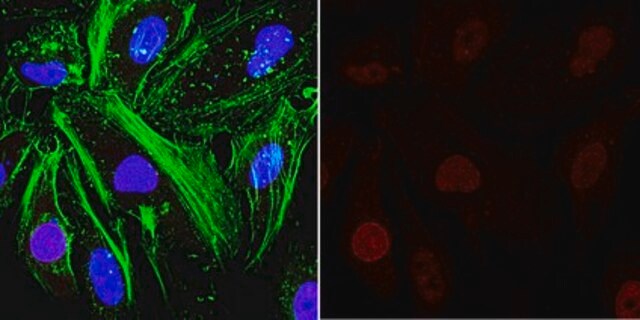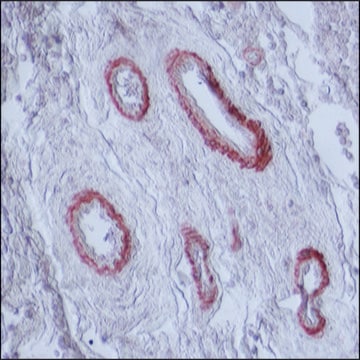MABF39-I
Anti-DC-STAMP Antibody, clone 1A2
clone 1A2, from mouse
Synonim(y):
Dendritic cell-specific transmembrane protein, DC-STAMP, Dendrocyte-expressed seven transmembrane protein, FIND, hDC-STAMP, IL-four-induced protein, Transmembrane 7 superfamily member 4
About This Item
Polecane produkty
pochodzenie biologiczne
mouse
Poziom jakości
forma przeciwciała
purified immunoglobulin
rodzaj przeciwciała
primary antibodies
klon
1A2, monoclonal
reaktywność gatunkowa
mouse, human
metody
flow cytometry: suitable
immunocytochemistry: suitable
immunoprecipitation (IP): suitable
western blot: suitable
izotyp
IgG2aκ
numer dostępu NCBI
numer dostępu UniProt
docelowa modyfikacja potranslacyjna
unmodified
informacje o genach
human ... DCSTAMP (81501)
Powiązane kategorie
Opis ogólny
Specyficzność
Immunogen
Zastosowanie
Inflammation & Immunology
Osteobiology
Western Blotting Analysis: 1.0 µg/mL from a representative lot detected DC-STAMP in thymus and spleen lysates from wild-type mice, and greatly reduced DC-STAMP in thymus and spleen lysates from Dcstamp-knockout mice (Courtesy of Grace Chiu, Ph.D., University of Rochester Medical Center, NY, USA).
Western Blotting Analysis: A representative lot detected the ~106 kDa dimeric and the ~53 kDa monomeric DC-STAMP band by Western blotting under non-denatured and denatured condition, respectively, following DC-STAMP immunoprecipitation using murine RAW 264.7 macrophage lysate (Mensah, K.A., et al. (2010). J. Cell. Physiol. 223(1):76-83).
Flow Cytometry Analysis: A representative lot detected DC-STAMP-positive lymphoctes and monocytes in purified human PBMCs (Chiu, Y.H., et al. (2012). J. Bone Miner. Res. 27(1):79-92).
Flow Cytometry Analysis: A representative lot detected DC-STAMP surface expression on murine RAW 264.7 macrophages and murine bone marrow-derived CD11b+ monocytes. DC-STAMP is expressed on osteoclast precursor (OCP) cells as a dimer, which is efficiently detected by flow cytometry using clone 1A2 (Mensah, K.A., et al. (2010). J. Cell. Physiol. 223(1):76-83).
Function Analysis: A representative lot inhibited RANKL & M-CSF treatment-induced osteoclasts (OC) formation in human PBMCs & monocytes cultures (Chiu, Y.H., et al. (2012). J. Bone Miner. Res. 27(1):79-92).
Function Analysis: A representative lot inhibited RANKL treatment-induced osteoclasts (OC) formation in RAW 264.7 and murine bone marrow macrophages cultures (Mensah, K.A., et al. (2010). J. Cell. Physiol. 223(1):76-83).
Immunohistochemistry Analysis: A representative lot detected DC-STAMP expressionon in multinucleated ‘osteoclast-like’ giant cells in human giant cell tumor of bone (Chiu, Y.H., et al. (2012). J. Bone Miner. Res. 27(1):79-92).
Immunocytochemistry Analysis: A representative lot detected DC-STAMP-positive human PBMCs using 10% NBF-fixed, paraffin-embedded cell preparation (Chiu, Y.H., et al. (2012). J. Bone Miner. Res. 27(1):79-92).
Immunocytochemistry Analysis: A representative lot detected differential DC-STAMP intracellular localizations by fluorescent immunocytochemistry staining of 4% paraformaldehyde-fixed, 0.1% saponin-permeabilized murine bone marrow macrophages at different time points during osteoclastogenesis upon RANKL treatment (Mensah, K.A., et al. (2010). J. Cell. Physiol. 223(1):76-83).
Immunoprecipitation Analysis: A representative lot immunoprecipitated DC-STAMP from the lysates of human monocytes (Chiu, Y.H., et al. (2012). J. Bone Miner. Res. 27(1):79-92).
Immunoprecipitation Analysis: A representative lot immunoprecipitated DC-STAMP from the membrane extracts of murine RAW 264.7 macrophages (Mensah, K.A., et al. (2010). J. Cell. Physiol. 223(1):76-83).
Jakość
Western Blotting Analysis: 4.0 µg/mL of this antibody detected DC-STAMP in 10 µg of mouse thymus lysate.
Opis wartości docelowych
Postać fizyczna
Przechowywanie i stabilność
Handling Recommendations: Upon receipt and prior to removing the cap, centrifuge the vial and gently mix the solution. Aliquot into microcentrifuge tubes and store at -20°C. Avoid repeated freeze/thaw cycles, which may damage IgG and affect product performance.
Inne uwagi
Oświadczenie o zrzeczeniu się odpowiedzialności
Nie możesz znaleźć właściwego produktu?
Wypróbuj nasz Narzędzie selektora produktów.
Kod klasy składowania
12 - Non Combustible Liquids
Klasa zagrożenia wodnego (WGK)
WGK 1
Temperatura zapłonu (°F)
Not applicable
Temperatura zapłonu (°C)
Not applicable
Certyfikaty analizy (CoA)
Poszukaj Certyfikaty analizy (CoA), wpisując numer partii/serii produktów. Numery serii i partii można znaleźć na etykiecie produktu po słowach „seria” lub „partia”.
Masz już ten produkt?
Dokumenty związane z niedawno zakupionymi produktami zostały zamieszczone w Bibliotece dokumentów.
Nasz zespół naukowców ma doświadczenie we wszystkich obszarach badań, w tym w naukach przyrodniczych, materiałoznawstwie, syntezie chemicznej, chromatografii, analityce i wielu innych dziedzinach.
Skontaktuj się z zespołem ds. pomocy technicznej







